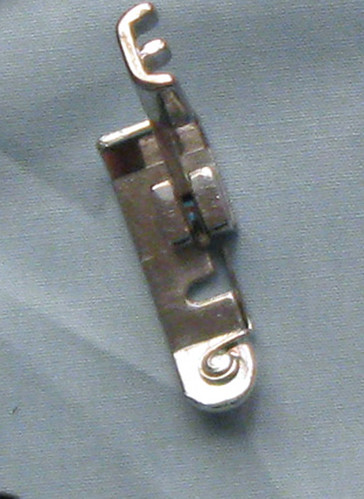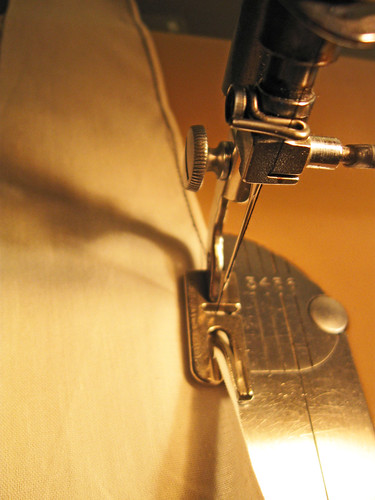Recently I posted about my new to me vintage Singer Rocketeer machine, and asked if anyone could identify this sewing machine foot which came with it. A few people asked me to post a follow up if I found out what it was, and I am happy to report . . .
Overcasting Foot
I sent an e-mail to Charlene Phillips of The Sew Box, who replied with the identification as well as some instruction on how to use it. She has written a very useful book about vintage sewing machine attachments and has a great website. Here is my original post about the book and using the gathering foot.
The answer is an Overcasting foot, and it creates a stitch along the edge of the fabric to finish the edge. In some respects it is the overlock stitch of a previous era. The only problem with this is that my machine does not seem to have any stitch or cam that creates the overcast stitch. So how to use it is still a mystery. She sent me a photo and the stitch is creates looks a lot like a blanket stitch on the edge of the fabric. I am sure those of you with those snazzy new electronic machines know all about this stitch - but we of the non-electronic era
must make do with our lovely steel attachments to get these fancy (useful) stitches.
Searching around the sewing blog world, I found this blog, Brian Sews, which has tons of great info on vintage sewing machines and attachments. I have been trying without any success to use the narrow hem foot. It could be incredibly useful for hemming silks, making dinner napkins and other items that have a very narrow hem however I could not get the hang of it. Thankfully, Brian has a great post with video on his blog showing how to use it.
So I have been practicing. The key to consistent hemming is how you hold the fabric feeding into the foot.
Here is the narrow hem foot in action.
Not yet ready for prime time, if I actually used it on a garment, I would be doing a lot of picking out stitches and re-doing which does not seem like fun. Example of my wobbly sttiching.
I see great potential for this foot - so useful, especially on children's clothes, sheer fabrics etc.
But not quite yet. I am seriously thinking about ordering the next size up, which I think is 1/4" narrow hem. Probably just as useful but not quite so tricky. I will let you know.
 And today's SunnyGal Garden photo - my neighbor gave me this plant several years ago. I just stuck it in the ground and now it is about 4 feet across. Aloe, so I am told.
And today's SunnyGal Garden photo - my neighbor gave me this plant several years ago. I just stuck it in the ground and now it is about 4 feet across. Aloe, so I am told. 













I do love seeing your narrow hem! Now lets see you do it on a curved edge.. ;) Speaking of your Rocketeer, in the video I do where I oil mine I actually missed a few oiling spots. There are some holes in the machine bed and the upright(Not sure what that part is called with the stitch length adjuster) that direct oil into parts of the machine you can't get to from the underside. Check them out and oil it up!
ReplyDeleteThe overcast foot is one of my favorite feet, mine looks a bit different though. If I had found the overcast foot earlier I might never have bought a serger! It produces such a nice edge finish... a handcrafted rather than factory produced look.
hi sunny gal! im happy to see you finding my blog, cos now i have another blog to read about old machines and sewing! :) i havent started any obsession with feets for my old machines yet, but i had barely learnt how to use a zipper feet and blind hem feet on my new machine! :) if you like to find old machines, you can go to niles district in fremont, i went last weekend and saw at least 6 old sewing machines :) but they were quite pricy....
ReplyDeletei also saw a old (not sure if it works, looks black like mine but in a small carrier) singer at an antique shop in willow glen the other week, going for only 25 i think... hmm! :)
woo, just saw the comment that overcast feet == serger... interesting!!!
ReplyDeleteTips to starting the rolled hem in the rolled hemmer feet.
ReplyDelete1. Take a couple of stitches with the machine in the corner of the fabric where you want to start hemming. Set your machine to right between reverse & forward on the stitch length, and it locks the stitches in place. Pull your fabric out of the machine & leave a 6" tail. That way when you start your rolled hem, you can hold onto the tails of thread to help get the rolled hem feeding properly before the fabric gets far enough onto the feed dogs.
2. Roll the hem & press it first, that makes it much easier to get & keep it rolled during stitching.
3. Only use woven fabrics, knits tend to get all puckered.
4. If you have trouble getting the rolled hem started with previous ideas, a unique tip that works with some fabrics is to cut off just the tip of the corner where you are starting your hem, so you remove a tiny triangle of the fabric. Roll your hem by hand, & the missing triangle of fabric seems to make it easier to feed the fabric into the little curl of the rolled hemmer foot. Once you get the rolled hem started, always keep the fabric feeding into the hemmer at a slight angle that ensures that the curl is always kept just full of fabric as you stitch. Once you practice it a few times with the right size needle, type of fabric, angle & manner of holding the fabric, it seems like it miraculously just starts working!
5. BEST TIP- if you happen to have a rolled hemmer foot with the zig zag opening for the needle instead of the single hole for straight stitch only, it is MUCH easier to do the rolled hem with a zig zag stitch, because the zig zag stitch ensures that the roll is caught by the needle & stitched down constantly, whereas a straight stitch is much easier to accidentally miss the roll of fabric if you accidentally feed it crooked the wrong way, so you get more gaps with straight stitching. You wouldn't believe that it actually took me 10 years after learning to do a rolled hem on a serger before I even realized you COULD use a zig zag stitch on a rolled hem & have it look OK! LOL!
BTW, your overedge foot is a FANTASTIC foot to use with just a zig zag stitch of any settings! It works on almost any kind of fabric, and is an absolute TREASURE! I only recently acquired one of these after sewing for 34 years. I honestly did not know an overcasting stitch could be made to look so neat & professional without a serger until I saw one online along with sample stitches. I was blown away!
I finally have realized that what makes many of the European made sewing machines special is that they had a wider variety of specialty feet easily available that make every sewing task so much easier! In sewing factories, specialty feet are what make it possible to make clothing in bulk fast enough for it to be sold cheaply.I would absolutely have purchased one of these feet decades ago if I knew they existed!
Becky tumorfarmer@yahoo.com